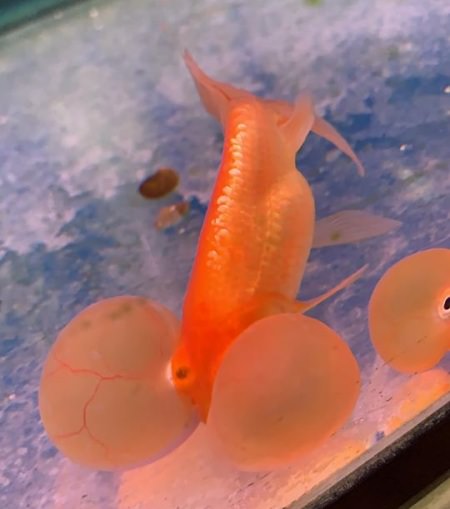| Back to Back Issues Page |
 |
|
The Goldfish Gazette, Issue #072-- Fancy Variety Care December 30, 2019 |
Goldfish Care TipsA Free Monthly Resource For Goldfish Enthusiasts In This Issue The difference in care requirements between single tail varieties and fancy varieties is massive, but to the inexperienced Goldfish keeper, Goldfish care is assumed to be the same whatever the variety. Fancy Variety Care All credit to the Goldfish owner who posted this image on Facebook from his local fish store, concerned that an inexperienced aquarist will probably buy this fish which will highly likely end badly for both. With the availability of very fancy Goldfish varieties becoming more common, new Goldfish keepers to the hobby appear to be unaware that the care requirements of a Common Goldfish are vastly different to a Water Bubble Eye, despite them both being "Goldfish". If more than two or three Goldfish of different varieties are going to be kept together, then their environment needs to meet the requirements of all the inhabitants, and not give an unfair advantage to a few. The unfair advantage I am referring to is primarily about food. Are all the inhabitants in the aquarium able to compete for food equally? I’ve covered the feeding problems different varieties have in issue #039 of The Goldfish Gazette, so I want to concentrate more in this issue on the actual aquarium environmental requirements for different fancy varieties. The only general comment I would make regarding feeding is, you can get away with feeding poor quality food to single tailed varieties, but fancy varieties don’t tolerate it for long, and sooner or later your fish will develop digestive problems, usually indicated by buoyancy issues. Fancy Variety levels of Ability to CompeteAll single tailed varieties, the Common, Comet, Shubunkins, can complete with each other equally for food, but within the fancy varieties, there are different levels of ability to compete, loosely based on eye type, but other physical characteristics also play a part.1. Level one, normal eyed varieties 2. Level two, telescopic eyed varieties 3. Level three, upturned eyes (Celestials) 4. Level four, Water bubble Eyes Aquarium EnvironmentThe main consideration for normal eyed fancy varieties is fin development.Veiltails, (Broadtails), and butterfly tailed fish need an uncluttered aquarium. Don’t heavily plant the aquarium as they will often tear their fins when trying to navigate through plants. There should not be a strong water current in the aquarium as long finned varieties can waste a lot of energy just fighting the current. Many new to Goldfish keeping don’t realize that telescopic eyed varieties are myopic, they can’t see anything at any distance. Telescopic eyed fish often seem to mysteriously lose an eye when housed with larger normal eyed fish. There should be no sharp objects in the aquarium in case a fish blunders into one if startled. I personally haven’t had fish knock one of their eyes out, but I have had fish injure themselves. Celestials with their upturned eyes can only feed from the surface or from the bottom by locating food by smell. Substrate or gravel (if any) should be small enough to stop food falling out of reach before the fish can find it, but not of a size that poses a choking risk. This applies to any Goldfish variety and why I have bare bottom aquariums, having lost fish to choking. Water Bubble Eyes are the variety that requires the most care. All the previous requirements mentioned are required for this variety plus a few more. Filter intake tubes can suck in the delicate water filled sacs, even though they have grills on them. There can be nothing sharp in the aquarium. This includes equipment, plants or gravel/substrate. The water flow produced by either the filter or aeration should not be strong enough to affect swimming. Water Bubble Eyes with large bubbles have enough trouble swimming without having to fight against a current. SummaryThe main take away from this is, if you are mixing varieties, be aware of how the setup of the aquarium could make it harder for some fish to compete for food, and monitor how much food each fish is getting.Varieties you would consider having near enough to the same ability to compete for food can be quite different in practice. As an example, my Celestials were hogging the food when they were in with Water Bubble Eyes, but when I moved them into the Black Moor pond, the opposite happened. P.S. May you, your family, and your Goldfish have a Happy New Year. Comments? Ideas? Feedback? I'd love to hear from you. Just reply to this e-zine and tell me what you think, or what topics you want covered. Next Month's Topic Disease symptoms, primary or secondary?www.facebook.com/aboutgoldfish |
| Back to Back Issues Page |